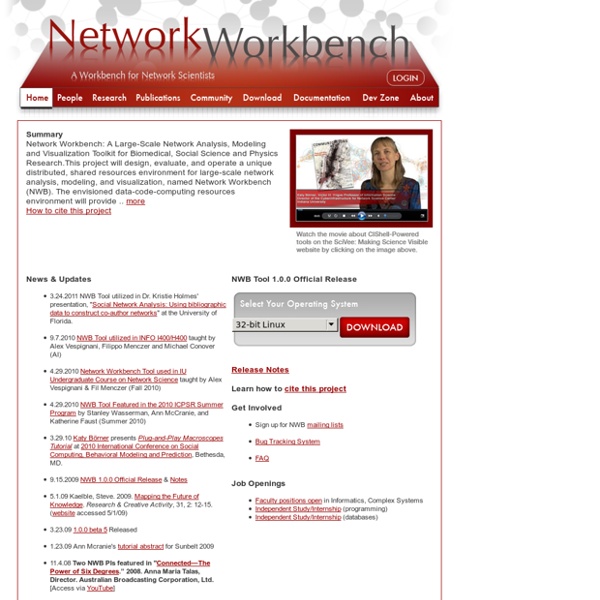



Cytoscape: An Open Source Platform for Complex Network Analysis and Visualization GUESS: The Graph Exploration System Gephi, an open source graph visualization and manipulation software NodeXL: Network Overview, Discovery and Exploration for Excel - Home LyX | LyX – The Document Processor Quelques outils pour visualiser les réseaux sociaux L’analyse des réseaux sociaux permet de mieux comprendre le comportement des acteurs et des communautés : quelle est la place de l’acteur au sein de l’ensemble ? Est-il central ? périphérique ? Cette analyse permet de comprendre en profondeur le fonctionnement des communautés en ligne. L’analyse des réseaux sociaux se fait en trois temps distincts : la récupération des données, leur analyse et leur visualisation. Sur de petits graphes, il est possible de faire la récupération des données a la main. Les données qui sont récupérées concernent le lien : qui est lié à qui ou à quoi, mais on pourra également s’intéresser au volume d’information produits, à sa fréquence et faire quelques corrélations. Navicrawler est une extension Firefox qui explore le contenu et la structure des pages web. Navicrawler n’assurant que la récolte des données, leur traitement doit se faire avec un autre programme : Pajek, Guess, Network Workbench Tool, ou NodeXL. Le tutorial de Guess WordPress: J'aime chargement…
OpenProj Open Source Project Management Software — Serena Software OpenProj is a free and powerful open source desktop alternative to Microsoft Project. Serena released OpenProj in 2008 as an open source code project. OpenProj is no longer supported by Serena. Please visit the SourceForge website to find out more. OpenProj provides project managers the rich functionality they expect, including Gantt charts, WBS and more - minus the costs of commercial desktop tools. Rich functionality OpenProj offers the rich functionality project managers need to run their projects – including Gantt and PERT charts, WBS (work breakdown structure) and RBS (resource breakdown structure) charts, Earned Value costing, and more. Multiple formats: OpenProj enables project managers to easily work with Microsoft Project and Oracle Primavera files. Global usage: OpenProj can run on virtually any computer – including Windows, Mac, UNIX, and Linux. Agile Project Management
Navicrawler | WebAtlas UPDATE: There now a portable version of Firefox with Navicrawler included: More information on these: These folders are zipped. Unzip and run “Firefox Portable”. You might have some obvious messages, and after that you have a fully functionnal Firefox 3.6 with Navicrawler installed.These are portable apps, it means that they do not interfere with other versions of Firefox that you might have. They do not install, you have to run them from their folder.Two other extensions are also installed: Flem and Greasemonkey. Regular versions: You can download the Navicrawler 1.7 or the Navicrawler 1.8b (now hosted directly on WebAtlas.fr). The Navicrawler is no longer supported. In this “next generation Navicrawler” you will be able to dynamically change the boundaries of every website, to have graphs with pages and websites at the same time, and to declare aliases (the same website with different domain names). Documentation (in French):
Git - Fast Version Control System OutWit, l'outil indispensable pour les recruteurs / sourceurs Je connais Michel Sarfati depuis 2010 et ma rencontre avec lui au premier #TruLondon… Nous étions les 2 seuls français présents à l’évènement. Depuis ce fameux #TruLondon, Michel a énormément réfléchi aux questions liées au sourcing et comment avec des outils améliorer les requêtes de recherche mais aussi automatiser le recueil d’informations. Dans cet entretien, Michel nous présente un outil très populaire aux Etats-Unis, OutWit, mais créé par un français (c’est mon cocorico !) Le plus impressionnant avec cet outil est sa capacité à labourer le web et à accumuler et classer n’importe quel contenu... Bonjour Michel, qui es-tu ? Je suis de formation Ingénieur (Centrale Paris 1988), et ai comme passion et spécialité l’informatique, depuis …. Je débute ma carrière en 1989 chez ACCENTURE où j’interviens en responsabilités croissantes sur d’importants projets de conseil et d’intégration de Systèmes d’information. Qu’est ce que OutWit ? OutWit a fait l’objet d’une distinction par OSEO.
The R Project for Statistical Computing Épisodes Vous voulez connaître les habitudes des usagers de téléphonie mobile ? Big Data. Vous voulez rejoindre une clientèle ciblée sur le Web? 2015 est l’année du Big Data. Des méga-croisements de données Des analyses statistiques, il y en a toujours eu. Aujourd’hui, on les produit par quintillions ces données. Pourtant, la véritable révolution du Big Data, ce n’est pas tant une question de grandeur que la manière dont on peut désormais croiser ces données. Catégoriser pour mieux régner Pour y voir clair dans ce fouillis d’informations, les algorithmes identifient des répétitions ou des modèles dans de larges segments de la population. Pour que les algorithmes fonctionnent adéquatement, il faut classer les individus dans des catégories toujours plus précises. Prédictions et discriminations Comme le rappelle Kate Crawford, interviewée dans l’épisode 05, ce sont les minorités et les populations déjà discriminées qui sont les plus affectées par les erreurs de prédictions. Faites le test